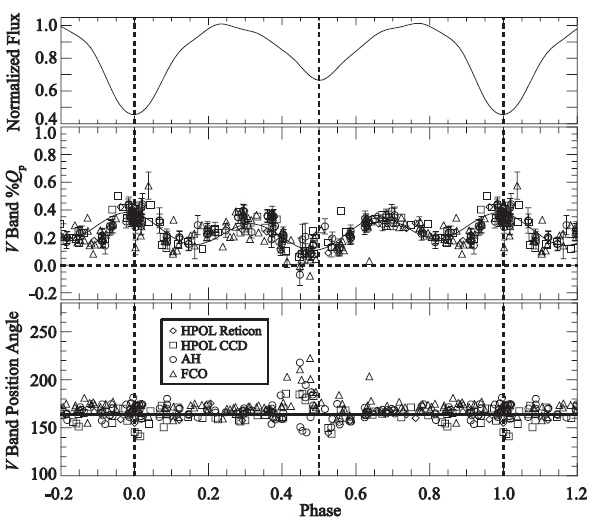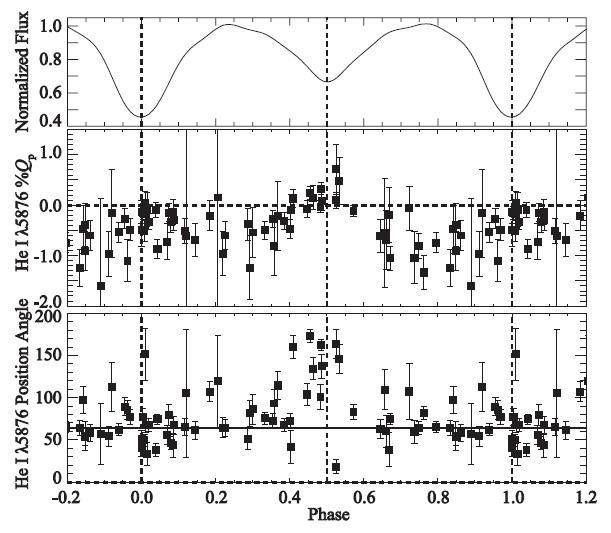



Beta Lyrae is an eclipsing, semi-detached, binary star system. The primary star is a B6-8 II giant that is losing material through Roche lobe overflow. The secondary, B0.5 V main sequence star is surrounded by an opaque ac-cretion disk created by the mass transfer process (Hubeny& Plavec 1991). Bipolar outflows have also been detected in the system (Harmanec et al. 1996, Hoffman et al. 1998). A ‘hot spot,’ due to the mass stream impacting the edge of the disk, has been theorized to exist but light curves of the system have not revealed its existence.
Recent work by Ak et al. (2007) and Zhao et al. (2008) support our current understanding of the beta Lyrae sys-tem.Interferometric images of the system clearly show the disk and primary star as separate objects (Zhao et al.2008), and the results of an analysis of a larger number of spectra are consistent with the presence of a disk and bipolar outflows (Ak et al. 2007).
Since the system’s two stars are hot, gas in the outflows and disk is at least partially ionized. Therefore, the sys-tem’s observed polarization is due to electron scattering. This process retains geometric information about the scattering region. Consequently, polarimetry can be used to probe the geometric structure of the disk and outflows to determine whether the theorized hot spot exists, since it would create a disruption in the otherwise smooth structure of the disk edge. Polarimetry can also help con-strain the location of the source of the bipolar outflows.
Three spectropolarimetric data sets were used in this study. The first data set was originally published in Ap-penzeller& Hiltner (1967) and taken between 1964 and 1966. The second set of observations was taken with the Flower and Cook Observatory (FCO)’s photoelastic modulating polarimeter instrument between 1987 and 1992. The last consists of 6 years of new and recalibrat-ed observations taken with the University of Wisconsin’s Half-Wave Spectropolarimeter (HPOL) between 1992 and 1998, a portion of which was originally published in Hoff-man et al. (1998).
Each data set has been corrected for interstellar polar-ization effects and rotated to the average position angle of 164o. This places the majority of the polarimetric varia-tions in the new projected %
The phase for each observation was calculated using the ephemeris
where
The %
secondary eclipse in polarized light that occurs before the secondary eclipse in total light (phase 0.483 compared to phase 0.5). It has a corresponding position angle rotation away from 164?. A position angle of 164? is consistent with the system’s axis on the sky and indicates the
At phase 0.483, the primary star has already begun its eclipse of the disk and the mass stream should lead the loser as it moves across the edge of the disk (Lubow & Shu 1975). The polarized secondary eclipse should thus oc-cur when the area disrupted by the hot spot and eclipsed by the primary star is maximized. Simple estimates for the size of the hot spot can be made using this new in-formation. Assuming the orbits are circular and the hot spot’s height is the same as that of the disk edge, a simple geometric analysis of the polarized light curve gives an estimated maximum hot spot width of approximately 30 solar radii (roughly equal to the disk radius). A simi-lar analysis of the position angle rotation yields a larger estimate. A third estimate utilizes a simple model of the polarized flux of the system. Assuming the polarization of the disk is uniform across the disk edge, this model pro-duces an estimate similar to the geometric analysis of the polarized light curve (about 30 solar radii). Full modeling of the polarized light curves will also help to better con-strain the hot spot size.
4. HE I (5,876 A) LINE RESULTS
The He I (5,876 A) line is polarized at a position angle (64?) perpendicular to the
Full results of this study, including
Long-term periodic behavior has been detected in the beta Lyrae system (Harmanec et al. 1996). However, due to the uneven time coverage of our combined data set, advanced period-finding techniques are required to find such periodicity in the polarization results.

